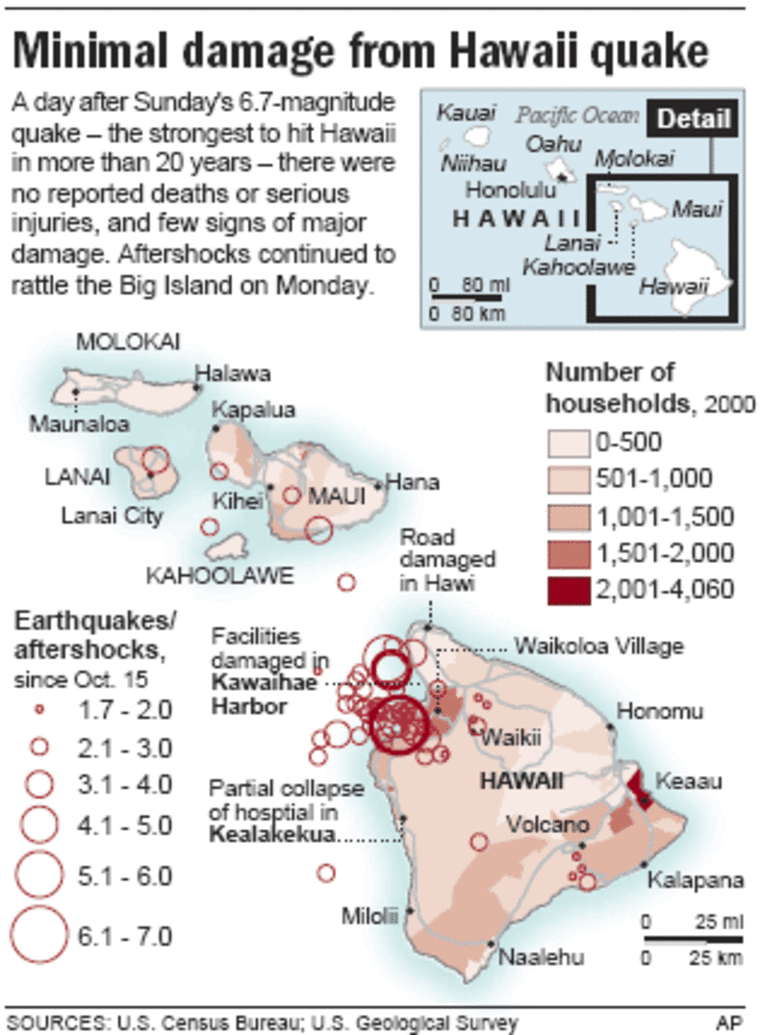Scientists are investigating whether a magnitude-6.0 earthquake that rocked Hawaii within minutes of Sunday's 6.7 temblor was a separate quake and not an aftershock.
The lead scientist at the U.S. Geological Survey's Hawaiian Volcanoes Observatory and a seismologist at the Pacific Tsunami Warning Center said Wednesday they were two independent events. Others aren't so sure.
The 6.7-magnitude quake struck 12.5 miles northeast of the Big Island's Kona airport at a depth of 24 miles at 7:07 a.m. Sunday. Seven minutes later, the 6.0-magnitude quake struck 27 miles north of the airport at a depth of about 12.5 miles.
Jim Kauahikaua, the scientist-in-charge at the observatory, said the difference in depths establishes that the two are "independent."
But Egill Hauksson, a seismologist at the California Institute of Technology, said it's too early to categorize the magnitude-6.0 event.
Scientists still need to analyze the pattern of aftershocks in the coming months before determining whether the smaller event was an aftershock or a triggered earthquake, Hauksson said. "There's more research to be done," he said.
Seismologist Vindell Hsu, of the tsunami center, said it's not uncommon for earthquakes to trigger others and it has happened in Alaska and at California's San Andreas Fault. "A major earthquake may trigger or activate a neighboring fault and start another good-sized earthquake," Hsu said.
Kauahikaua expects several opinions. "Some of these earthquakes get worked on for years. Different techniques come up. People have different points of view," he said. "This is our assessment within the first three days after the earthquake. If somebody can make a powerful argument the other way, fine."
Aftershocks are a series of smaller earthquakes that occur after the main shock and in the same geographic area. Aftershocks can rock a region for months or years. Generally, the bigger the main shock, the more intense the aftershocks will be.
Dozens of aftershocks have been recorded since the initial quake.
Hawaii County Mayor Harry Kim, who served decades as the Big Island's civil defense chief, said the latest quakes came after a long stretch of seismic calm.
Kim said a third to half of the population had never experienced a quake of Sunday's magnitude.

Since 1960, the Big Island has been hit with 31 earthquakes with a magnitude greater than 4.0. But Sunday's first earthquake was the largest recorded since a 6.7 occurred under the east flank of Mauna Loa Volcano on November 16, 1983.
The island also experienced a 7.2-magnitude quake on November 29, 1975, and an estimated 7.9 temblor on April 2, 1868.
The vast island — spread across more than 4,000-square miles of lava fields, rain forests and pasture lands — was formed by several volcanoes. Kilauea is one of the most active volcanoes in the world, spewing lava and expanding the island's surface.
Preliminary damage estimates from the earthquake hit $73 million and President Bush declared a major disaster, ordering federal aid to help state and local recovery efforts.
Kim said one of the reasons the island didn't sustain more damage than it did was the strict building codes that have evolved over decades of natural disasters.
Buildings on the Big Island must meet the strictest level of any of the Hawaiian Islands. There are no buildings taller than 100 feet. There are also no highway overpasses.